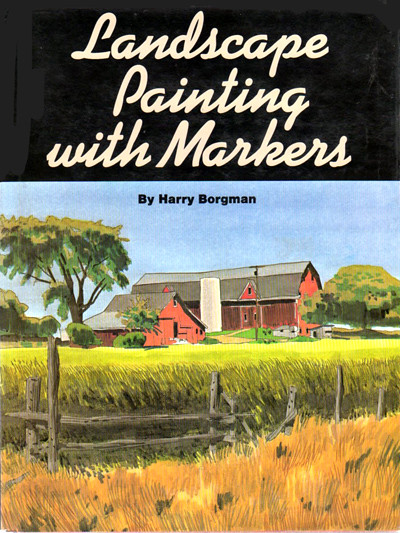When I was the head of the Advertising Department at the Society of Arts and Crafts in Detroit (now the College for Creative Studies) I could not find contemporary instructional books to recommend to my students, so I thought about writing a few. I worked up a presentation and sent it to Watson Guptill Publications, the book was titled DRAWING IN INK. They bought the idea, but suggested that I first do a book on painting with markers. The editor knew that I worked with markers on advertising renderings and felt that it would make a fine book. I wasn't sure about how successful a book on painting with markers would be, but I dove right in and finished it so I could get started on the book that was my favorite subject, drawing in ink. The Editor in Chief gave me great advice before I began, he said "You don't have to know how to spell....and don't buy a yacht".
Long out of print, these books can be found on Amazon or other used book dealers at very low prices, in case you are interested. There is a new Dover reprint, PEN AND PENCIL DRAWING TECHNIQUES which is also available.

A few of the books that I have written, including DIGITAL DREAMS, which is about experimenting with digital art, it's available from Xlibris.

Here is the first instructional book that I wrote. I am going to post some examples from it on this blog.




8 comments:
Hi Harry,
Did you have favourite art books? (Not authored by you).
What were some that influenced you?
Hi Vince,
I was influenced by many books when I was a kid, can't remember all the titles, but all books by Ernest Watson and Arthur Guptill ( little did I know that I would be writing books for their company one day ). The Art of Pencil Drawing by Watson, Rendering in Pencil by Guptill and any book about or by Elliot O'Hara, the watercolorist, were favorites of mine. The best book of all was On the Art of Drawing by Robert Fawcett, it's been reprinted and is well worth buying, check out Amazon.com. Also the new book About Robert Fawcett, as well as the book about Noel Sickles, both are amazing.
Harry
Hi Harry,
How does the contents of Drawing in Ink differ from Pen and Pencil Drawing Techniques (the 2002 repro)?
My interest is in illustrating stories in the Graphic Novel genre. The style of your SPAD and the racing car have appealed to me since childhood.
Along those lines (pardon the pun), what value does drafting (mechanical drawing)have in illustrating, and is there an exercise book you can recommend?
Hi Long Runner,
Pen and Pencil Drawing Techniques are pretty much the same as Drawing in Ink, if I remember correctly, but it does not contain everything that is in the original book.
Mechanical drawing is important if you are going to illustrate objects like automobiles or aircraft, although I have never taken classes in that subject, it can be learned by yourself. I don't have a book on the subject that I could recommend. In a lot of areas of illustrating an artist is pretty much on his or her own as far a learning goes, many teachers are not well versed on these subjects and good books are rare. The learning process is part of the fun in this business, although it can be very difficult at times.
Harry
Loving the blog Harry. Enjoying the posts on ink line drawing!
Hi Randall,
Thanks, it's also one of my favorite subjects. However, I am running out of ink line art to post. Hope that I can dig up more stuff. By the way, someone just notified me that Heritage Auctions is auctioning several of my aircraft illustrations in early May.
Harry
Hi Harry,
I'm using a photo of a V8 engine as the basis for an illustration, but I find that the perspective and slight fish-eye is such that the pulleys are slightly distorted. I'm concerned about achieving a sharp, clean ink line, but an elliptical template won't match them and neither will a French curve. Any thoughts?
Speak of French curves, how do you remember which curve you used when you are redrawing? Do you label them or something?
And, in a tight corner with a 107 crow quill, the ink on the back of the nib starts to bleed off on to the French curve. Would I have less trouble if I raised the curve off the paper more? I remember my dad sticking pennies to the bottom of his.
By the way, dad worked for Elgin Davis in Los Angeles on and off in the 60s and 70s. Ever hear of him?
Hi Long Runner,
It's pretty hard to use a Crowquil pen when using a French curve, I always use a technical pen. Also I raise the curves by putting some masking tape on the under side. To draw an odd elliptical shape, you can use smaller sections of different ellipse guides or just sections of a French curve. I don't label my curves, I guess that I just remember which ones I used. I'm not familiar with Elgin Davis in LA. What was your dad's name, it's possible that I've heard of him.
Harry
Post a Comment